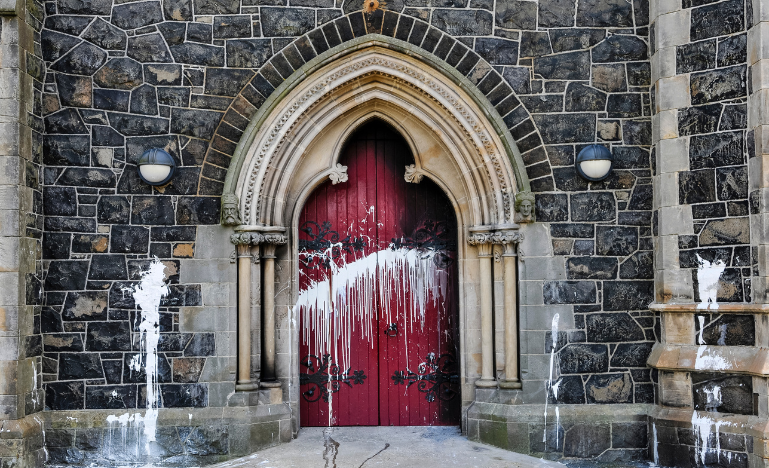Symbolic legislation or an invitation to over-police?
Observers say if the new hate crimes created by C-9 aren’t enforced, it’s going to be a pyrrhic victory

In response to the rise in anti-semitism and other hate-motivated crimes in Canada, the Liberal government tabled its promised hate crime legislation early in the fall sitting.
Bill C-9 would amend the Criminal Code to make it an offence to intimidate and obstruct people from accessing places of worship, as well as schools, community centres, and other places primarily used by identifiable groups. Known as The Combatting Hate Act, it also criminalizes wilfully promoting hatred against an identifiable group by displaying certain terrorism or hate symbols in public, and makes hate-motivated crime a stand-alone offence. The goal is clearer denunciation and ensuring that offenders are held accountable.
When tabling the bill, Justice Minister and Attorney General Sean Fraser was adamant that it does not create “bubble zones,” which establish protest-free areas around designated buildings, such as abortion clinics, as that is the domain of provinces and municipalities. He said great care was taken to ensure this legislation would not impair legitimate protests.
Not everyone is mollified by Fraser’s assurances, however.
An open door to over-police?
Anaïs Bussières McNicoll, director of the fundamental freedoms program at the Canadian Civil Liberties Association, is concerned the legislation, as currently drafted, could criminalize protesters. That’s because the new intimidation provision criminalizes conduct that’s intended to provoke a state of fear in another person and impede their access to certain locations. She says the list of locations is broad and vaguely defined, and the notion of intent to create a state of fear is a vague and subjective concept.
“The provision could easily be read by police to capture protests that are peaceful, even if they are offensive or disruptive,” Bussières McNicoll says.
While welcoming the action to address hate and violence against 2SLGBTQI communities, Egale Canada shares concerns about over-policing. Communications Director Jennifer Boyce says the vague offences risk criminalizing 2SLGBTQI protests and putting an undue burden on their communities.
“Improvements are needed, such as defining distances similar to ‘bubble zone’ laws and ensuring that symbol provisions cannot be used against 2SLGBTQI communities in the future, as we have seen done in other countries.“
There are also concerns that this legislation may only prove to be symbolic, given that there are already hate provisions in the Criminal Code, which police are simply not enforcing.
“I do appreciate the government introducing anti-hate legislation early in its legislative agenda,” says Mark Sandler, chair of the Alliance of Canadians Combatting Antisemitism.
“I think that is responsive to the spike in antisemitism and other hatred that we’re seeing across Canada, but the prime impediment to prosecuting hate-motivated criminals has not been the absence of adequate laws.”
While the offences created by C-9 have symbolic importance, given the significant message they send, he believes that priority should be given to enforcing existing laws. This includes offences related to mischief, disrupting religious worship, and intimidation.
While he thinks the new intimidation offence will be difficult to prove based on the element of intentionality, Sandler strongly supports having a stand-alone hate offence over the existing consideration of hate as an aggravating factor.
“On conviction, a person’s criminal record will reflect the hate-motivated crime they’ve committed. That’s important because we see a number of hate-mongers are repeat offenders,” he says.
“If they’re just convicted of threatening death or assault, the criminal record would not show it’s a hate-motivated offence.”
Kyla Lee of Acumen Law in Vancouver and past chair of the CBA’s criminal justice section, takes a different view. She’s concerned that the standalone offence exposes people to greater criminal liability.
“The problem that arises is that there are now two offences needing to be defended against at once, with the defence to one of them being applicable to both, but there being no apparent defence to the standalone offence for hate,” Lee says, speaking on her own behalf as the section has not yet taken a position on the bill.
“So, it’s really just creating a legislated double jeopardy.”
She predicts it will create a mess of the law and take longer to resolve cases, increasing the burden on the justice system.
“We do have a problem with hate, but we don’t have a lot of these offences charged, so if we’re going to make the offences that are charged more complicated, it’s going to take time away from the things that are actually occupying the justice system,” Lee says.
Streamlining hate crime charges
The bill repeals the existing offence of mischief respecting places of worship and other vulnerable spaces when the motivation is based on bias, prejudice, or hate. While this was likely done under the belief that the new obstruction and intimidation offences would be sufficient, Sandler thinks the existing wording should be retained.
“Right now, we see a lot of vandalism of places of worship and community centres, and in order to convict someone of mischief under section 430(4.1), you need only prove that it was motivated by bias, prejudice or hate—it doesn’t have to meet the threshold of pure hate, which is a higher onus,” he says.
“It’s a significant difference, but it’s been lost in the discussion.”
Bill C-9 aims to streamline the process of laying hate propaganda charges by removing the requirement to obtain the attorney general’s consent, which should allow police to move more quickly. Although he’s often been frustrated with the bureaucracy and lack of will shown at times in laying charges, Sandler nevertheless opposes repealing this requirement.
“Superficially, it sounds very attractive,” he says, noting it was originally introduced to avoid abuse of the hate propaganda provisions.
“I’ve seen examples where people seek to weaponize these provisions when the evidence doesn’t warrant their use. I can see in this highly polarized environment that we now live in that our community could justifiably be concerned about the misuse of these provisions in the absence of the attorney general’s consent.”
Lee agrees that the consent provision should be maintained, as there is a possibility that hate offences could marginalize already marginalized communities, especially given the history of queer and trans people’s interactions with police.
In an interview with Power & Politics, former Ontario attorney general Yasir Naqvi said the consent process was onerous because it couldn’t be delegated. Now that there is more maturity in the hate crimes legislation, he no longer thinks it’s necessary.
Sandler says instead of removing that “safety valve,” the better solution is for the federal and provincial governments to demonstrate their attorneys' general commitment to laying charges in appropriate cases, and to create a more expeditious process for seeking and obtaining that consent.
He also thinks the law is missing provisions around criminalizing the glorification of terrorism. He’d prefer to see language about wilful promotion that is consistent with other parts of the Criminal Code, which deal with wilful promotion or hatred of an identifiable group. It’s something he hopes to propose when the bill is under review at committee.
Regardless of where things land, Sanders hopes that changing the hate crimes on the books isn’t just a symbolic gesture.
“If these new laws are not going to be enforced, it’s going to be a pyrrhic victory for the community.”


